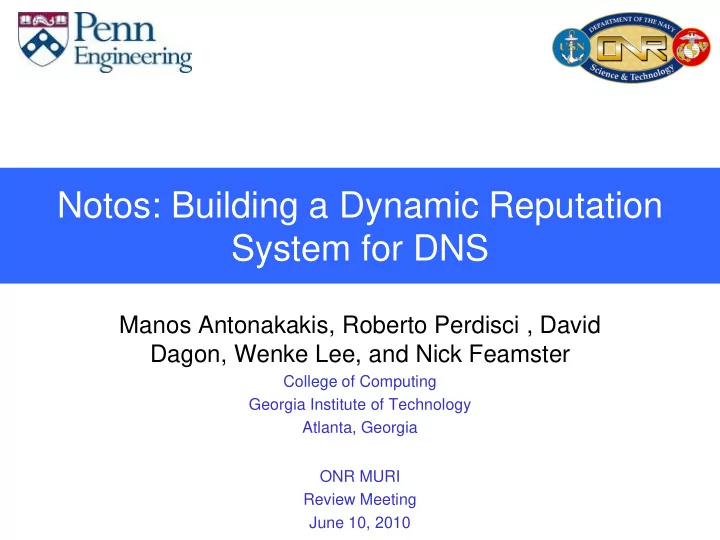

Notos: Building a Dynamic Reputation System for DNS Manos Antonakakis, Roberto Perdisci , David Dagon, Wenke Lee, and Nick Feamster College of Computing Georgia Institute of Technology Atlanta, Georgia ONR MURI Review Meeting June 10, 2010
Problems with Static Blacklisting • Malware families utilize large number of domains for discovering the “up -to- date” C&C address – Examples are the Sinowal, Bobax and Conficker bots families that generate tens of thousands new C&C domains every day – IP-based (dynamic or not) blocking technologies cannot keep up with the number of IP addresses that the C&C domains typically use – DNSBL based technologies cannot keep up with the volume of new domain names the botnet uses every day • Detecting and blocking such type of agile botnets cannot be achieve with the current state-of-the-art 11/4/09 ONR MURI Review 2
Outline • Notos – Notations, Passive DNS trends, and anchor- zones – Network based profile modeling – Network and zone based profiles clustering – Reputation function – System implementation – Results • Conclusions and Future Work 11/4/09 ONR MURI Review 3
Notos • Network and zone based features that capture the characteristics of resource provisioning, usages, and management by domains. – Learn the models of legitimate and malicious domains • Classify new domains with a very low FP% (0.3846%) and high TP% (96.8%). – Days or even weeks before they appear on static blacklists. 11/4/09 ONR MURI Review 4
Notation & Terminology • Resource Record (RR) – www.example.com 192.0.32.10 • 2nd level domain (2LD) and 3rd level domain (3LD) – For the domain name www.example.com: 2LD is the example.com and 3LD is the www.example.com • Related Historic IPs (RHIPs) – All “routable” IPs that historically have been mapped with the domain name in the RR, or any domain name under the 2LD and 3LD • Related Historic Domains (RHDNs) – All fully qualified domain names (FQDN) that historically have been linked with the IP in the RR, its corresponding CIDR and AS 11/4/09 ONR MURI Review 5
Passive DNS data • Successful DNS resolutions that can be observed in a given network • Data set has traffic from 2 ISP sensors - one in west coast and one in east coast, also data from SIE • We observe that different classes of zones demonstrate different passive DNS behaviors • The number of new domain names and IPs we observe every day is in the range of 150,000 to 200,000 11/4/09 ONR MURI Review 6
Passive DNS trends Anchor classes in pDNS: Akamai, CDN, Popular, DYNDNS and Common 11/4/09 ONR MURI Review 7
Features Notos computes three feature vectors for a RR, based on its RHIPs, RHDNs and Evidence data. The analysis of these feature vectors is forwarded to the reputation engine. These 3 vectors are the Network Based Feature Vector [18], Zone Based Feature Vector [17] and the Evidence Based Feature Vector [6]. 11/4/09 ONR MURI Review 8
Network Profile Modeling • Train a Meta-Classifier based on the 5 anchor-classes • The network feature vector of a domain name d is translated into the network modeling output (NM(d)) The NM(d) is a feature vector composed from the confidence scores for each different anchor-class 11/4/09 ONR MURI Review 9
Domain Clustering The network and zone based feature vectors of a domain d are used to produce the domain clustering output (DC(d)) In this step we are able to characterize unknown domains within clusters based on already labeled domains in close proximity . The DC(d) is a 5-feature vector characterizing the position of d in the cluster . 11/4/09 ONR MURI Review 10
Reputation Function • Each domain d in our dataset is transformed into three feature vectors by Notos: NM(d) , DC(d) and EV(d) (evidence profile output); these vectors assemble the reputation vector v(d) • The reputation function f(v(d)) assigns a score to the domain name d between [0,1] • The reputation function is a statistical classifier (Decision Tree with Logistic Boost - after model selection) • The reputation function is trained using labeled domain data 11/4/09 ONR MURI Review 11
Operational Model of Notos • Notos utilizes the Off-line mode to train classifiers, build the clusters and train the reputation function • In the In-line mode , Notos assigns reputation to new RRs observed at the monitoring point 11/4/09 ONR MURI Review 12
11/4/09 ONR MURI Review 13
Results from the Reputation Function FP%=0.3849% and TP%=96.8% 11/4/09 ONR MURI Review 14
Results from the Reputation Function (cont’d) # of days the detection earlier than public BLs 11/4/09 ONR MURI Review 15
Tech Transfer • Damballa is actively evaluating Notos • ISPs are interested in having us extend this line of research • DNS vendors and other network operators – Have been spending millions of $ and years trying to build similar system, but fail to match Notos ’ capability/performance – Trying to get Notos technologies 11/4/09 ONR MURI Review 16
Conclusions and Future Work • Conclusions: – Combining network, zone, and evidence features provides the ability to dynamically associate unknown domains to known domains/networks • Benefits: with limited labeled domains we can identify new malicious ones, much sooner than BLs • Future Work: – Targeted detection: use an additional clustering step based on association with specific fraudulent domain name class (RBN, Zeus, etc.) to enable targeted detection – Combine Notos with Spam/Flux detection systems 11/4/09 ONR MURI Review 17
Recommend
More recommend